With the newest update of the Basepaws Cat DNA Report, your cat's breed index was notably changed. Our database has significantly increased, thus allowing us to add more breeds, improve breed relativity accuracy and adapt the breed group classification. Your newest Basepaws breed report is the most accurate one yet, and we are very proud to present the new improvements to you!
New breeds are being added
Since the early beginnings, Basepaws has been continually adding new breeds to report in parallel to the database growth. Now that our database has expanded, we were able to add four new breeds to the Basepaws breed report, and we are not stopping here. New breeds will continue to be added as we collect more data. The breeds added with this iteration are: Egyptian Mau, Exotic Shorthair, Himalayan and Peterbald. You can find the up-to-date complete list of all the breeds included in the breed report here.
Breed classification is adapted
In your previous Basepaws breed report, the breeds were classified into three breed groups: Western, Eastern and Hybrid. Our genomic analysis has revealed that a large group of cats is actually genetically isolated from these three breed groups, thus creating their own distinct cluster. These cats are the Persian and related breeds. We have categorized these cats into a separate breed group we named "Persian", after its oldest breed in the tree. The Persians were first popularized in England from Turkey and Iran/Persian areas in the late 1800s. These cats were known for their long, thick coat and round face, differentiating themselves from the Turkish Angoras present at the time. Over time, Persians have been bred to have increasingly short faces, one of them most distinct physical features of the breed as we know it today.
Persian cats were extremely popular in England, as their grand silky coat was favored by the queen herself. Due to this popularity, Persians cats were used to found a variety of variants, such as Himalayan cats, as well as used to improve or change the genetics of other established breeds, such as the British Shorthair. This consistent use of the Persian lines in breeding programs of other breeds has caused the entire breed to shift genetically far enough in our analysis to be considered their own distinct breed group! Thus, your report will now include a brand new breed group: Persian cats.

We are particularly thrilled to finally have enough data to add the Egyptian Mau breed into the Basepaws breed report. Among other newly added breeds, Egyptian Maus are the ones with very curious genetic background and they have delivered some groundbreaking changes to our current presentation of the breeds. Maus are athletic, medium sized cats who, as their name suggests, likely originated from the areas around Egypt. Egyptian Maus are the only domestic cats with a naturally spotted coat pattern, a unique feature that has deservingly stolen the hearts of many cat lovers. Because of their size, athleticism and uniquely captivating coat, these cats were commonly used as the domestic foundation breed to be outcrossed to Asian Leopard Cats for the creation of Bengals. They were also periodically used for the creation of the Savannah breed.
Although the Egyptian Mau is an Eastern breed, because of this implication in the creation of Hybrid cats, our analysis has shown that they are genetically a lot more closely related to our two hybrid breeds (Bengal and Savannah) than other Eastern breeds. As a result, we have added this new breed to our Hybrid breed group and we have renamed the group accordingly to: Exotic cats. The newest breed report will, therefore, present four breed groups: Western, Eastern, Persian and Exotic. The complete list of breeds classified into these four groups can be found here.
Complete breed appendix
Up until now, we have placed each tested cat into one of the breed groups in which they got the highest breed match. As a result, only cats from this group were used for analysis of other breed matches. For example, if your cat's highest match was a Western breed, only cats from the Western group of breeds were used for comparisons even if your cat was actually genetically similar to other breeds, for example Eastern. We chose to display the results in this way to help understand the relativity within the similar breed groups.
After further analysis of our customers' results and our purebred database, we have decided to change how we display the results. Since many of our samples have a variety of genetic influences from both the Eastern, Western, and Hybrid breed groups (and our new Persian group!), the breed appendix will now include cats from ALL four breed groups. Thus, you will now be able to see ALL the top breed matches for your cat. This more accurately represents the polycat-ness of your kitty and showcases the unique mixture that each and every one of our little hunters represents!

As excited as we are to finally share the newest Basepaws breed report with you, this is a very large update and we will, therefore, be releasing it gradually over the next few months. Make sure to keep an eye on your email for our notification on when to log in to check your new report out. If you have any questions about the upcoming updates or you need help reading your report, please don't hesitate to contact us to meow@basepaws.com. We cannot wait for you to see the final product!
More about your Basepaws Cat DNA Report:
1. Announcement: New 2019 Basepaws Cat DNA Report 2. Basepaws Health Marker Report 3. List of Breeds 4. List of Health Markers 5. Chromosome Map 6. Understanding Your Basepaws Report



